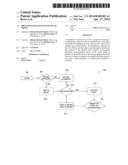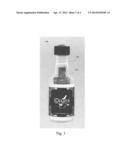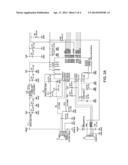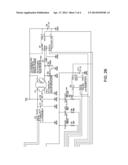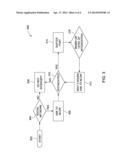Patent application title: BREATHALYZER SYSTEM FOR SOCIAL MEDIA
Inventors:
Michael Patrick Burke (West Long Branch, NJ, US)
Daniel Farkas (St. Petersberg, FL, US)
IPC8 Class: AH04L2906FI
USPC Class:
726 4
Class name: Access control or authentication network authorization
Publication date: 2014-04-17
Patent application number: 20140109185
Abstract:
A breathalyzer system for use with a computer consisting of a
breathalyzer, computer software and hardware, an interface and method for
delaying posts by persons who cannot prove sobriety upon initial posting.
The breathalyzer registers the level of sobriety, and the result is sent
through an interface to the software. If the alcohol level is below an
acceptable threshold, unencumbered access to the social media is granted.
If the alcohol level is above an acceptable threshold, access to
websites, posting on social media websites, uploading videos, online
gambling, or making large purchases is restricted.Claims:
1. A method for regulating posts to social media networks by persons with
a history of intoxication, comprised of the following steps: a
breathalyzer system is installed to a computer, said breathalyzer system
comprised of a breathalyzer unit, computer software for monitoring
alcohol levels and granting access to alcohol-sensitive websites, and
standard computer interfaces; the software receives input to recognize an
alcohol threshold level; the software receives input to recognize at
least one alcohol-sensitive website; the software prompts a user to
breath into the breathalyzer unit when the user attempts to access the at
least one alcohol-sensitive website; and the software delays, restricts,
or grants access to the at least one alcohol-sensitive website under the
following conditions: when the software registers an alcohol level beyond
the alcohol threshold level, the software restricts or delays access to
alcohol-sensitive websites; when the software registers an alcohol level
below the alcohol threshold level, the software grants access to
alcohol-sensitive websites; when the breathalyzer is removed, the
software restricts or delays access to alcohol-sensitive websites.
2. The method of claim 1, wherein the software receives input from a user to recognize an alcohol threshold level upon installation or where the software registers an alcohol threshold level below a currently set alcohol threshold level.
3. The method of claim 1, wherein alcohol-sensitive websites include social media websites, websites for uploading videos, online gambling websites, and websites for making online purchases.
4. The method of claim 1, wherein in the case of online social media, the software delays a post by buffering the post for at least one hour before prompting the user to register his alcohol level again, and wherein the software grants the post if the software registers an alcohol level below the alcohol threshold, but further buffers the post for at least one additional hour before prompting the user to register his alcohol level again.
5. The method of claim 4, wherein once the software registers an alcohol level below the alcohol threshold, the software presents all buffered posts to the user with an option to send, delete or save the posts.
6. The method of claim 1, wherein if the software registers an alcohol level above the alcohol threshold, the software further provides a list of favorite non-alcohol sensitive websites.
7. The breathalyzer unit of claim 1 comprised of: a housing that a person can blow into that contains a microcontroller for processing data; an alcohol and ethanol sensor for sending intoxication data to the microcontroller; an Electrically Erasable Programmable Read-Only Memory chip to store data when power to the device is removed; a data connection to a computer; a power source; and and software that can buffer or allow a user's actions on the Internet.
8. The breathalyzer system of claim 7, wherein the housing is bottle-shaped.
9. The breathalyzer system of claim 7, wherein the data connection to the computer is achieved by a USB connection.
10. The breathalyzer system of claim 7, wherein the data connection to the computer is achieved by a Bluetooth connection.
11. The breathalyzer system of claim 7, wherein the data connection to the computer is achieved by an IEEE 802.11 connection.
12. The breathalyzer system of claim 7, wherein the power source is a battery.
Description:
CROSS-REFERENCE TO RELATED APPLICATION
[0001] This present application claims the benefit of Provisional Application No. 61/545,997 filed Oct. 11, 2011. The prior application is incorporated herein by reference.
FEDERALLY SPONSORED RESEARCH
[0002] Not Applicable
SEQUENCE LISTING OR PROGRAM
[0003] Not Applicable
BACKGROUND
[0004] The invention comprises a system, method, and apparatus for regulating posts to social media networks by persons with a history of intoxication. Currently, restrictions for making posts to social media relate to age requirements, and are largely based on the honor system. If a person uses obscenities, posts pornography, or misrepresents their identity, a content administrator may penalize the user or block their posts after the fact. Otherwise, the user is largely free to post what they desire.
[0005] As a result of this freedom, persons who are intoxicated are also free to post on social media, even though they may not be in the right frame of mind. Posting while intoxicated often causes damage to relationships, reputations, and careers. Because social networks do not regulate the ability to post while intoxicated, nor by law, it is incumbent upon a person with a history of intoxication to regulate his or her own conduct when participating in social media networks. This is difficult because a drinker sometimes does not know when he or she may be too intoxicated to participate in social media networks. For the foregoing reasons, there is a need for a breathalyzer system that can provide a means for limiting a person's own access to social media networks while intoxicated.
SUMMARY
[0006] The breathalyzer system consists of a breathalyzer, computer software and hardware, standard interfaces, and a method for delaying posts by persons who cannot prove sobriety upon initial posting. To post on a social network, the software will require a user to prove sobriety. This is accomplished by blowing into a breathalyzer connected to a user's computer. The breathalyzer registers the level of sobriety, and the result is sent through an interface to the software. If the alcohol level is below an acceptable threshold, for example, below 0.07%, the software will grant unencumbered access to the social media. If the alcohol level is above the acceptable threshold, the software will block and buffer the user's posts for a later time.
[0007] The intoxicated person may not know whether the post was successful. When the user later proves sobriety by blowing into the breathalyzer and registering an acceptable level of sobriety (below the acceptable threshold), the software will prompt the user to approve or deny posts made while he or she registered above the acceptable threshold (while he or she was intoxicated). The software can also intercept outbound emails and can send an alternate post instead. Intercepted posts and uploads will be buffered for review at a later time by the user.
DRAWINGS
[0008] FIG. 1 is a perspective view of a breathalyzer system according to one embodiment of the present invention.
[0009] FIGS. 2A and 2B shows a circuit diagram of a preferred embodiment of this invention. FIG. 2B is a continuation of FIG. 2A.
[0010] FIG. 3 is a flowchart of a preferred embodiment of this invention illustrating the sequence of software operation.
DESCRIPTION
[0011] As illustrated in FIGS. 1-3, the breathalyzer system is comprised of a breathalyzer 100 and computer software with standard interfaces that uses a method for delaying posts by persons who cannot prove sobriety upon initial posting. The "breathalyzer" 100 is the unit that the person blows into and houses a printed circuit board and a means for communicating with the computer. The computer software provides an interface where functions of the breathalyzer system are carried out. Because each person may have a different breath-alcohol threshold before intoxication occurs, each user can set his or her level in the system upon installation, or whenever the software registers an alcohol threshold level below a currently set alcohol threshold level. Alternatively, the computer software may be set to recognize intoxication levels set by law.
[0012] The breathalyzer shown in FIG. 1. The breathalyzer housing 104 can be in the form of a 50 ml plastic alcoholic nip bottle or any other shape suitable for containing the device's hardware 102. The hardware 102 includes an alcohol/ethanol sensor, a microcontroller, a micro-USB port, a rechargeable battery, an Electrically Erasable Programmable Read-Only Memory chip (EEPROM), light emitting diodes (LEDs), and Bluetooth or IEEE 802.11 connectivity. Now referring to circuit diagram in FIG. 2, the printed circuit board comprises the system electronics and analyzes the alcohol/ethanol content in the user's breath. The information is communicated to the computer through the USB port, Bluetooth, or an 802.11 connection.
[0013] FIG. 3 shows a flowchart, illustrating how the breathalyzer system software functions with regard to its environment. When the user starts their computer 302, the breathalyzer system is activated. If the user attempts to enter or use an "alcohol-sensitive" website 304 (i.e., one that has been designated as posing a risk of danger or embarrassment to the user when used while intoxicated), the system will prompt the user to blow into the breathalyzer 306. Alochol-sensitive websites can be determined by the user upon installing the breathalyzer system. Alternatively, the breathalyzer system may already recognize commonly used social media such as Twitter or Facebook as alcohol-sensitive website, with the option of designating additional social media websites. Using the breathalyzer may also be required to recover the computer from sleep mode or the screen saver. If the user is accessing a non alcohol-sensitive website, they will be allowed to advance 308. If the user is found to be intoxicated 310, they may be restricted from entering alcohol-sensitive websites, posting on social media such as Twitter or Facebook, uploading videos, online gambling, or making purchases 314 (e.g., Amazon, E-bay, stock market). Alternatively, the system may buffer the intoxicated user's post for one hour before once again testing the user for intoxication. When a user is found to be intoxicated, the device may also provide a list of favorite websites to be used while intoxicated.
[0014] Depending on the level of intoxication 316, the breathalyzer system may wait two hours and then ask the user to once again blow into the breathalyzer 312. If the device is removed, all alcohol-sensitive websites and applications will remain inaccessible. Once the user is found to be sober by the breathalyzer system, a log of all buffered posts will be presented to the user. The user may then decide whether to send, delete or save the posts.
[0015] The invention does not require that all the advantageous features and all the advantages need to be incorporated into every embodiment of the invention. Although the present invention has been described in considerable detail with reference to certain preferred versions thereof, other versions are possible. Therefore, the spirit and scope of the appended claims should not be limited to the description of the preferred versions contained herein.
User Contributions:
Comment about this patent or add new information about this topic:

